Metallurgical Effects of Niobium in Dual Phase Steel
Abstract
1. Introduction
2. Materials and Methods
3. Results
3.1. Characterization of As-Hot Rolled Condition
3.2. Characterization of Batch Annealed Condition
3.3. Characterization of Final Condition
3.4. Evolution of Niobium Precipitation
4. Discussion
4.1. Solubility Considerations and Precipitation Kinetics
4.2. Precipitation Strengthening
4.3. Microstructural Refinement and Homogenization
4.4. Microstructural Implications on Mechanical Properties
- Grain refinement is known to raise strength and toughness simultaneously. In conventional high strength steels with ferritic, ferritic-pearlitic or bainitic matrix grain refinement has a stronger effect on yield than on tensile strength. Thus, the cold working potential is diminished, and uniform elongation is reduced. In DP steel the influence of grain refinement however is opposite [24,25]. Consequently, the work hardening potential will be enhanced by refining the microstructure. The Hall–Petch coefficients for yield and tensile strength in DP steels related to ferrite grain size were determined by Ramazani et al. [26] as being 3.98 and 8.39 MPa∙mm−1/2, respectively. Accordingly, the strengthening contribution resulting from ferrite grain size in the present steel is estimated to be in the order of 70 and 150 MPa for yield and tensile strength, respectively. In comparison to typically coarser grained conventional DP steel with similar martensite volume fraction, the tensile strength increment by grain refinement is expected to reach up to 100 MPa [24,25].
- Precipitation strengthening in the ferrite phase [27] in combination with grain refinement results in more homogeneous strain distribution within the microstructure with the potential of postponing plastic instability or necking of the material towards higher strains, i.e., an improved strength-ductility balance can be expected.
- The very fine martensite size and the good separation of martensite islands from each other in the present steel is expected reducing void nucleation and growth along ferrite/martensite interfaces as well as obstructing cleavage fracture in martensite islands.
- The nano-sized niobium carbides dispersed within ferrite phase are expected to significantly increase dislocation density in the very beginning of deformation leading to large instant work-hardening. The dislocation loops formed around the precipitates reduce the effective mean-free path length (parameter L in Equation (5)) between particles with increasing Ashby-Orowan strengthening, i.e., work hardening as a consequence. With the progress of deformation, cross-slip on secondary slip planes can be activated in the vicinity of particles resulting in dynamic recovery [28]. Differential strain hardening analysis by Suppan et al. [6] on a similar high-ductility DP steel indeed observed such recovery behavior after initial straining. The work hardening behavior observed in the present steel (Figure 12b) reveals the same phenomenon after the initial very high strain hardening rate.
- The sequence of instant strain hardening by precipitates, followed by increasing dislocation pile-up against grain or phase boundaries, and finally retained austenite transformation provides a continuously high strain hardening rate over a wide deformation range. In this steel the strain hardening coefficient varies between 0.12 and 0.18 until homogeneous elongation is reached. It guarantees high strength in a formed component irrespective of the actual degree of strain in local areas of the part.
5. Conclusions
Author Contributions
Funding
Conflicts of Interest
References
- Hasegawa, K.; Kawamura, K.; Urabe, T.; Hosoya, Y. Effects of Microstructure on Stretch-flange-formability of 980 MPa Grade Cold-rolled Ultra High Strength Steel Sheets. ISIJ Int. 2004, 44, 603–609. [Google Scholar] [CrossRef]
- Pichler, A.; Traint, S.; Hebesberger, T.; Stiaszny, P.; Werner, E. Processing of thin sheet multiphase steel grades. Steel Res. Int. 2007, 78, 216–223. [Google Scholar] [CrossRef]
- Mohrbacher, H.; Klinkenberg, C. The Role of Niobium in Lightweight Vehicle Construction. Mater. Sci. Forum 2007, 537–538, 679–685. [Google Scholar] [CrossRef]
- Flaxa, V.; Kluge, S. Microalloyed Low-Carbon Multiphase Steels. Steel Res. Int. 2016, 87, 1264–1273. [Google Scholar] [CrossRef]
- Bouaziz, O.; Zurob, H.; Huang, M. Driving Force and Logic of Development of Advanced High Strength Steels for Automotive Applications. Steel Res. Int. 2013, 84, 937–947. [Google Scholar] [CrossRef]
- Suppan, C.; Hebesberger, T.; Pichler, A.; Rehrl, J.; Kolednik, O. On the microstructure control of the bendability of advanced high strength steels. Mater. Sci. Eng. A 2018, 735, 89–98. [Google Scholar] [CrossRef]
- Ordan’yan, S.S.; Avgustinik, A.I.; Kudryasheva, L.V. Densification of nonstoichiometric Niobium-carbide phases. Powder Metall. Met. Ceram. 1968, 7, 612–618. [Google Scholar]
- Irvine, K.J.; Pickering, F.B.; Gladman, T. Grain-refined C-Mn steels. J. Iron Steel Inst. 1967, 205, 161–182. [Google Scholar]
- Sharma, R.C.; Lakshmanan, V.K.; Kirkaldy, J.S. Solubility of Niobium Carbide and Niobium Carbonitride in Alloyed Austenite and Ferrite. Metall. Trans. A 1984, 15, 545–553. [Google Scholar] [CrossRef]
- Danoix, F.; Bémont, E.; Maugis, P.; Blavette, D. Atom Probe Tomography I. Early Stages of Precipitation of NbC and NbN in Ferritic Steels. Adv. Eng. Mater. 2006, 8, 1202–1205. [Google Scholar] [CrossRef]
- Hin, C.; Bréchet, Y.; Maugis, P.; Soisson, F. Kinetics of heterogeneous dislocation precipitation of NbC in alpha-iron. Acta Mater. 2008, 56, 5535–5543. [Google Scholar] [CrossRef]
- Perrard, F.; Deschamps, A.; Bley, F.; Donnadieu, P.; Maugis, P. A small-angle neutron scattering study of fine-scale NbC precipitation kinetics in the a-Fe–Nb–C system. J. Appl. Cryst. 2006, 39, 473–482. [Google Scholar] [CrossRef]
- Baker, R.G. Nutting, J. Precipitation Processes in Steels. J. Iron Steel Inst. Spec. Rep. 1959, 64, 1–22. [Google Scholar]
- Ohnuma, M.; Suzuki, J.; Wie, F.-G.; Tsuzaki, K. Direct observation of hydrogen trapped by NbC in steel using small-angle neutron scattering. Scr. Mater. 2008, 58, 142–145. [Google Scholar] [CrossRef]
- Nöhrer, M.; Mayer, W.; Primig, S.; Zamberger, S.; Kozeschnik, E.; Leitner, H. Influence of Deformation on the Precipitation Behavior of Nb(CN) in Austenite and Ferrite. Metall. Mater. Trans. A 2014, 45A, 4210–4219. [Google Scholar] [CrossRef]
- Ashby, M.F. Physics of Strength and Plasticity; Argon, A.S., Ed.; MIT Press: Cambridge, MA, USA, 1969; p. 113. [Google Scholar]
- Guo, Z.; Sha, W. Quantification of Precipitation Hardening and Evolution of Precipitates. Mater. Trans. 2002, 43, 1273–1282. [Google Scholar] [CrossRef]
- Huang, J.; Poole, W.J.; Militzer, M. Austenite Formation during Intercritical Annealing. Metall. Mater. Trans. A 2004, 35A, 3363–3375. [Google Scholar] [CrossRef]
- Bunge, H.J.; Vlad, C.M.; Kopp, H.-H. Recrystallization kinetics of a cold rolled dual-phase steel sheet. Arch. Eisenhüttenwesen 1984, 55, 163–168. [Google Scholar] [CrossRef]
- Garcia, C.I.; DeArdo, A.J. Formation of Austenite in 1.5 Pct Mn Steels. Metall. Trans. A 1981, 12A, 521–530. [Google Scholar] [CrossRef]
- Nakada, N.; Arakawa, Y.; Park, K.-S.; Tsuchiyama, T.; Takaki, S. Microstructural Control of Dual Phase Structure formed by Partial Reversion from cold-deformed Martensite. Mater. Sci. Forum 2013, 753, 191–194. [Google Scholar] [CrossRef]
- Schemmann, L.; Zaefferer, S.; Raabe, D.; Friedel, F.; Mattissen, D. Alloying effects on microstructure formation of dual phase steels. Acta Mater. 2015, 95, 386–398. [Google Scholar] [CrossRef]
- Available online: www.vda.de/en/services/Publications/vda-239-100.html (accessed on 1 February 2020).
- Park, K.-T.; Lee, Y.K.; Shin, D.H. Fabrication of Ultrafine Grained Ferrite/Martensite Dual Phase Steel by Severe Plastic Deformation. ISIJ Int. 2005, 45, 750–755. [Google Scholar] [CrossRef]
- Calcagnotto, M.; Ponge, D.; Raabe, D. Effect of grain refinement to 1 µm on strength and toughness of dual-phase steels. Mater. Sci. Eng. A 2010, 527, 7832–7840. [Google Scholar] [CrossRef]
- Ramazan, A.; Mukherjee, K.; Prahl, U.; Bleck, W. Transformation-Induced, Geometrically Necessary, Dislocation-Based Flow Curve Modeling of Dual-Phase Steels: Effect of Grain Size. Metall. Trans. A 2012, 43A, 3850–3869. [Google Scholar] [CrossRef]
- Kamikawa, N.; Hirohashi, M.; Sato, Y.; Chandiran, E.; Miyamoto, G.; Furuhara, T. Tensile Behavior of Ferrite-martensite Dual Phase Steels with Nano-precipitation of Vanadium Carbides. ISIJ Int. 2015, 55, 1781–1790. [Google Scholar] [CrossRef]
- Kamikawa, N.; Abe, Y.; Miyamoto, G.; Funakawa, Y.; Furuhara, T. Tensile Behavior of Ti, Mo-added Low Carbon Steels with Interphase Precipitation. ISIJ Int. 2014, 54, 212–221. [Google Scholar] [CrossRef]
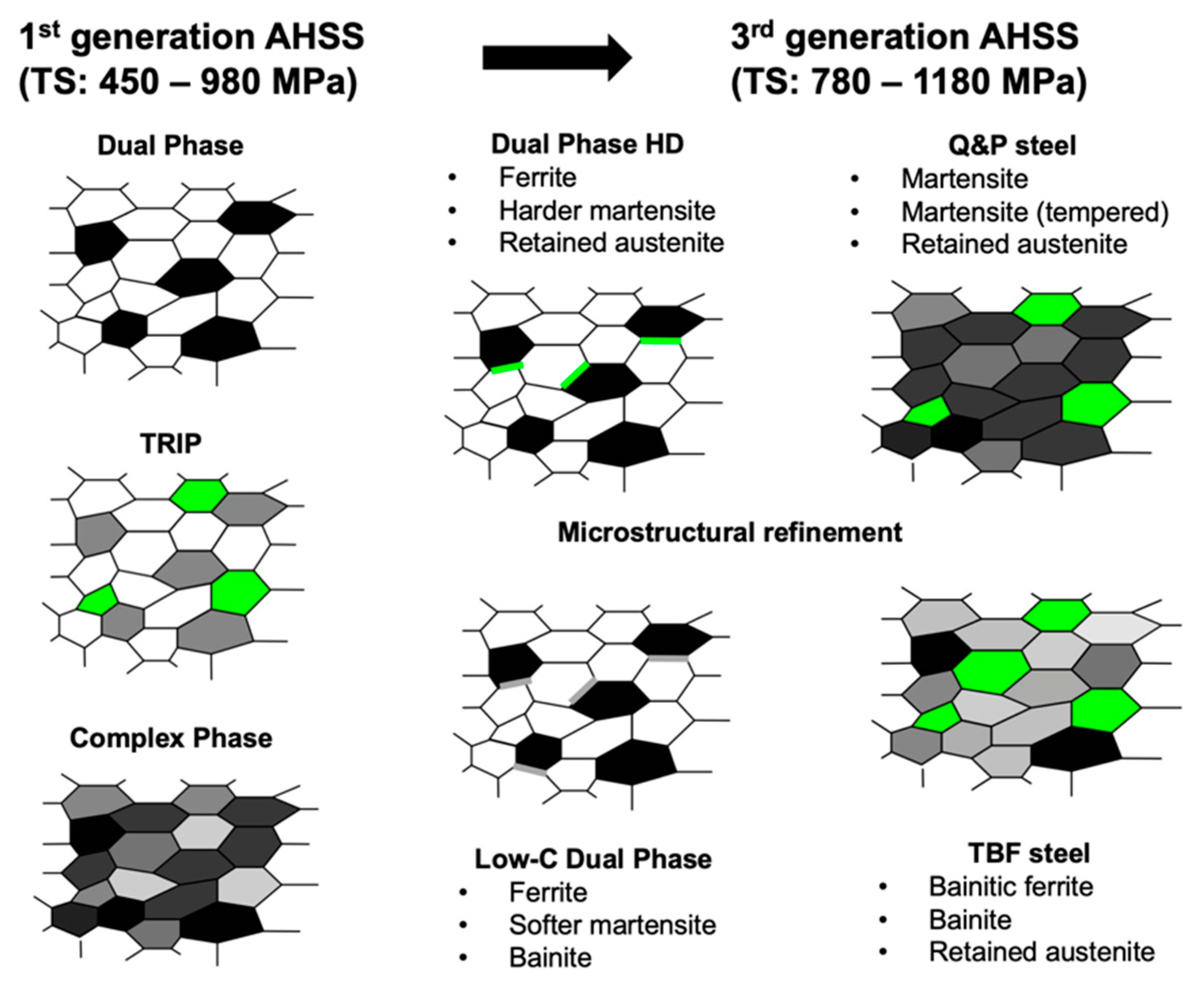
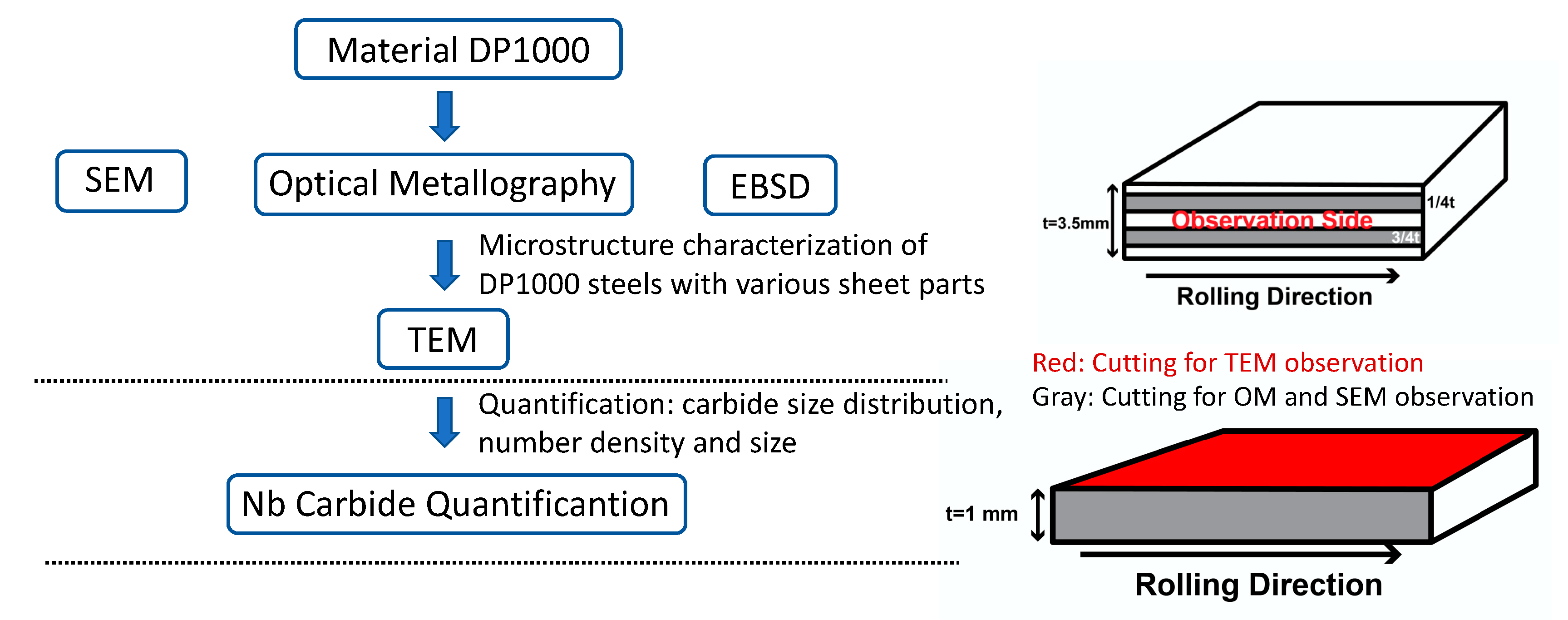

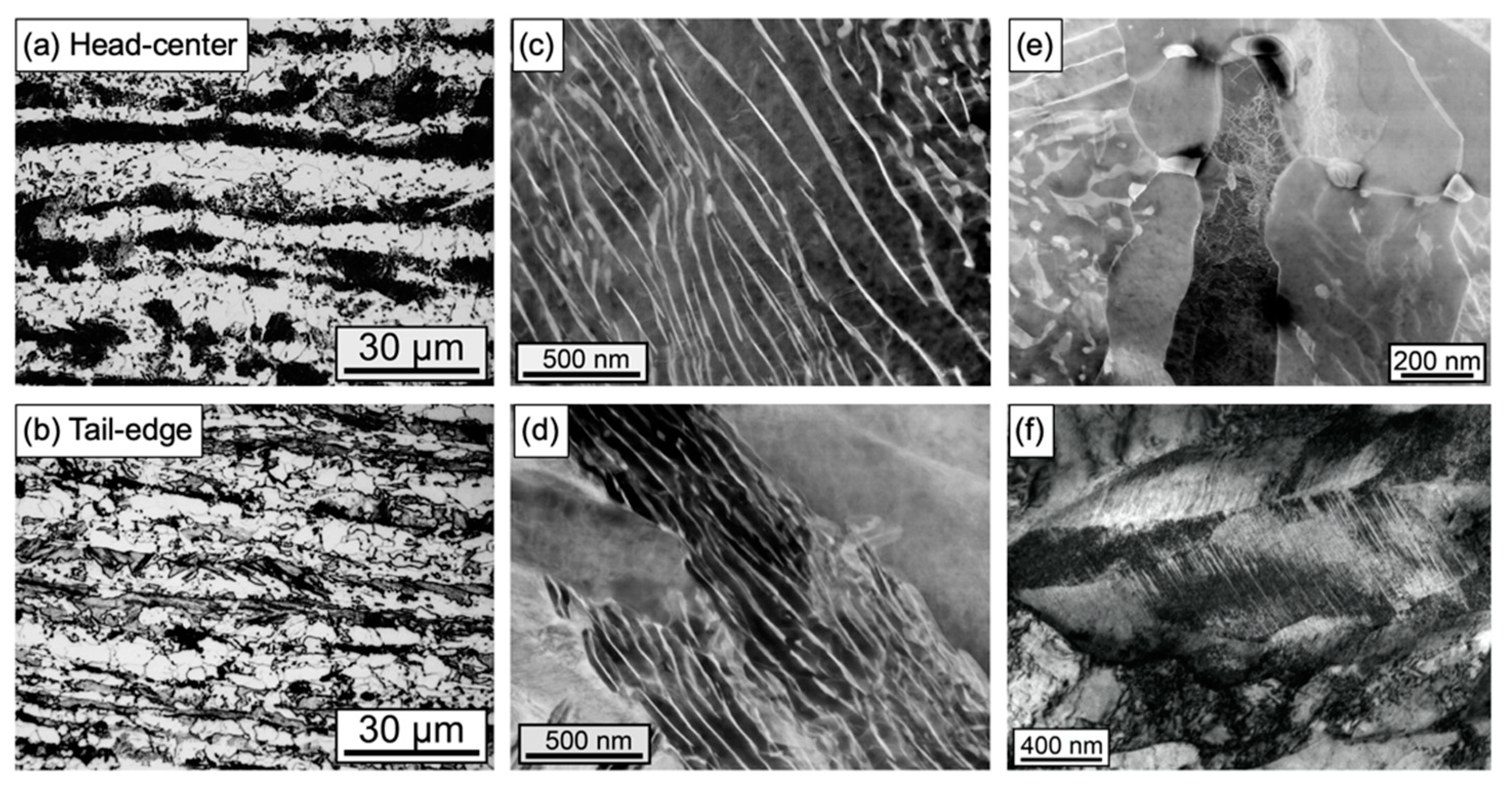
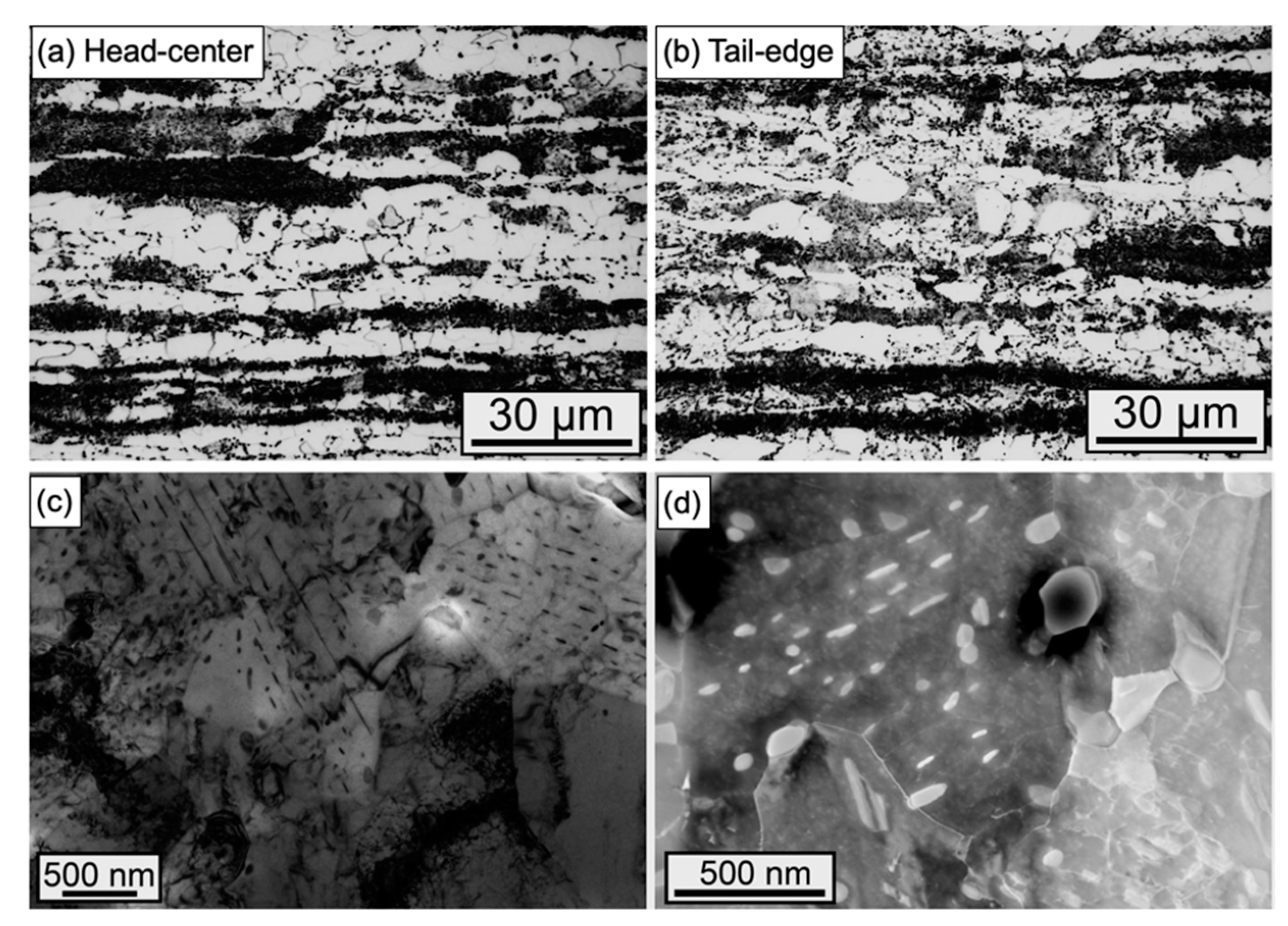
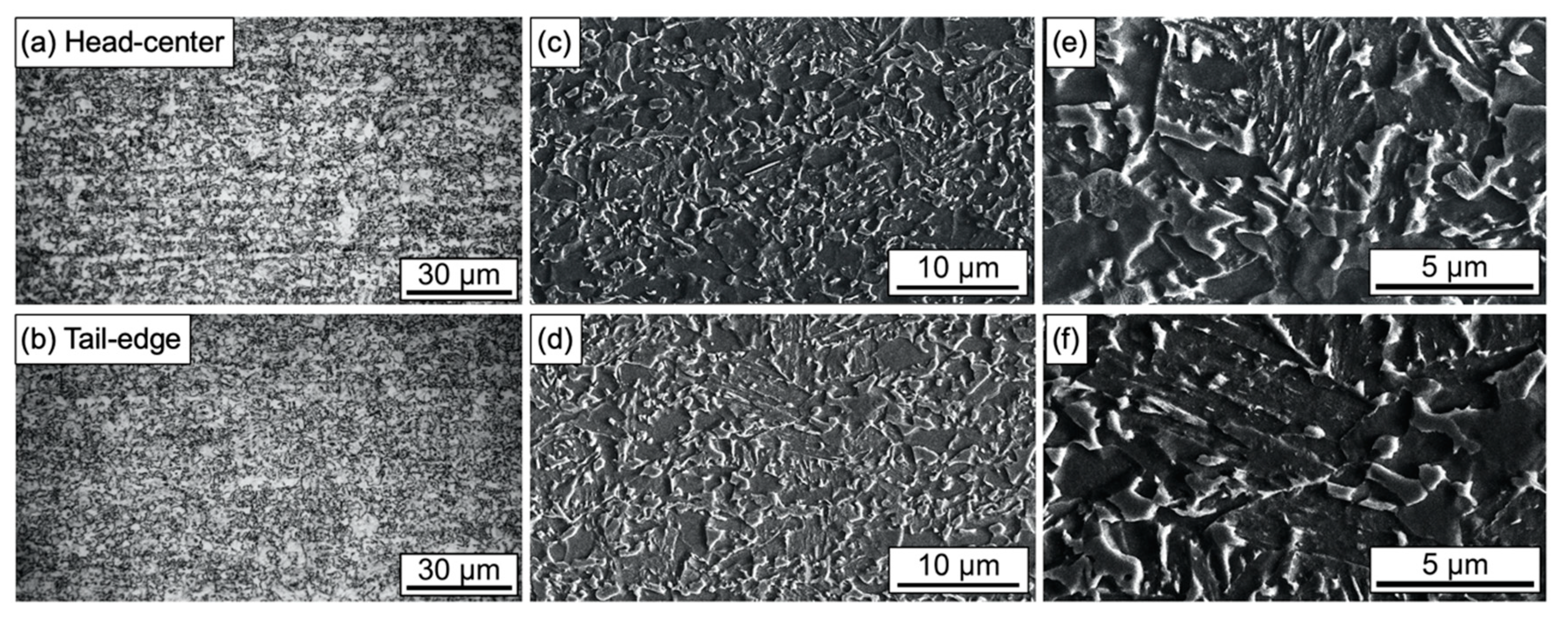

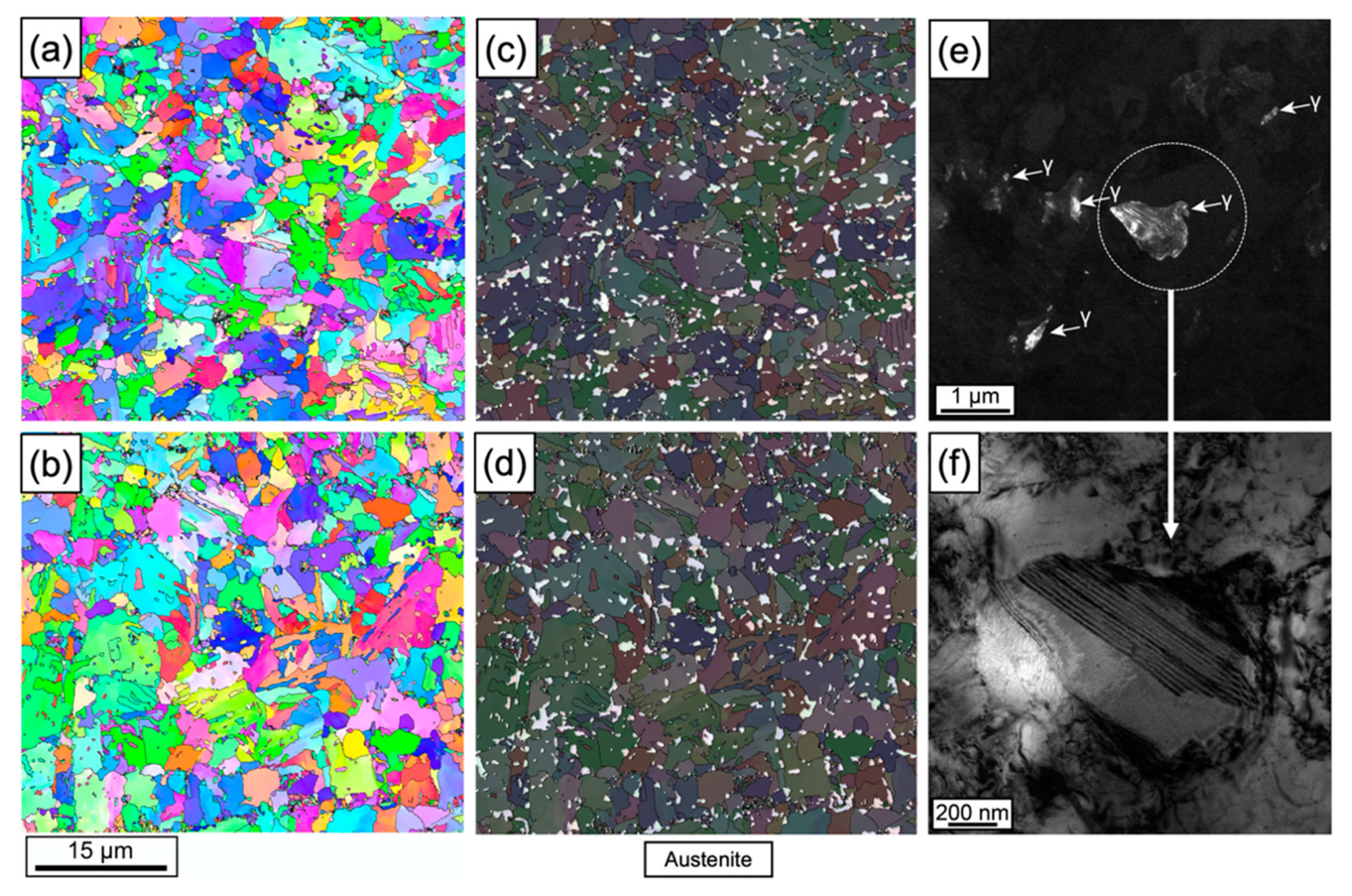
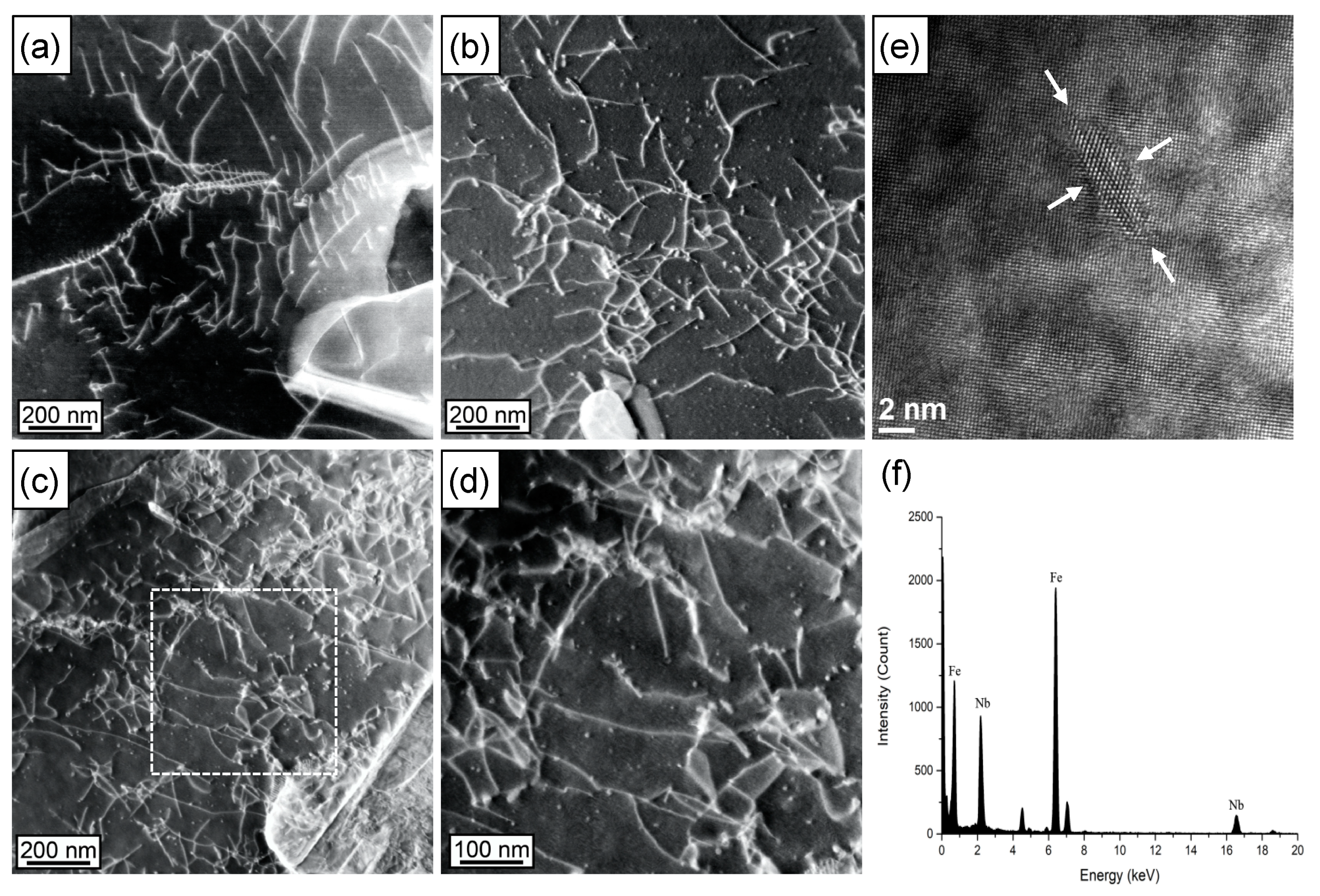
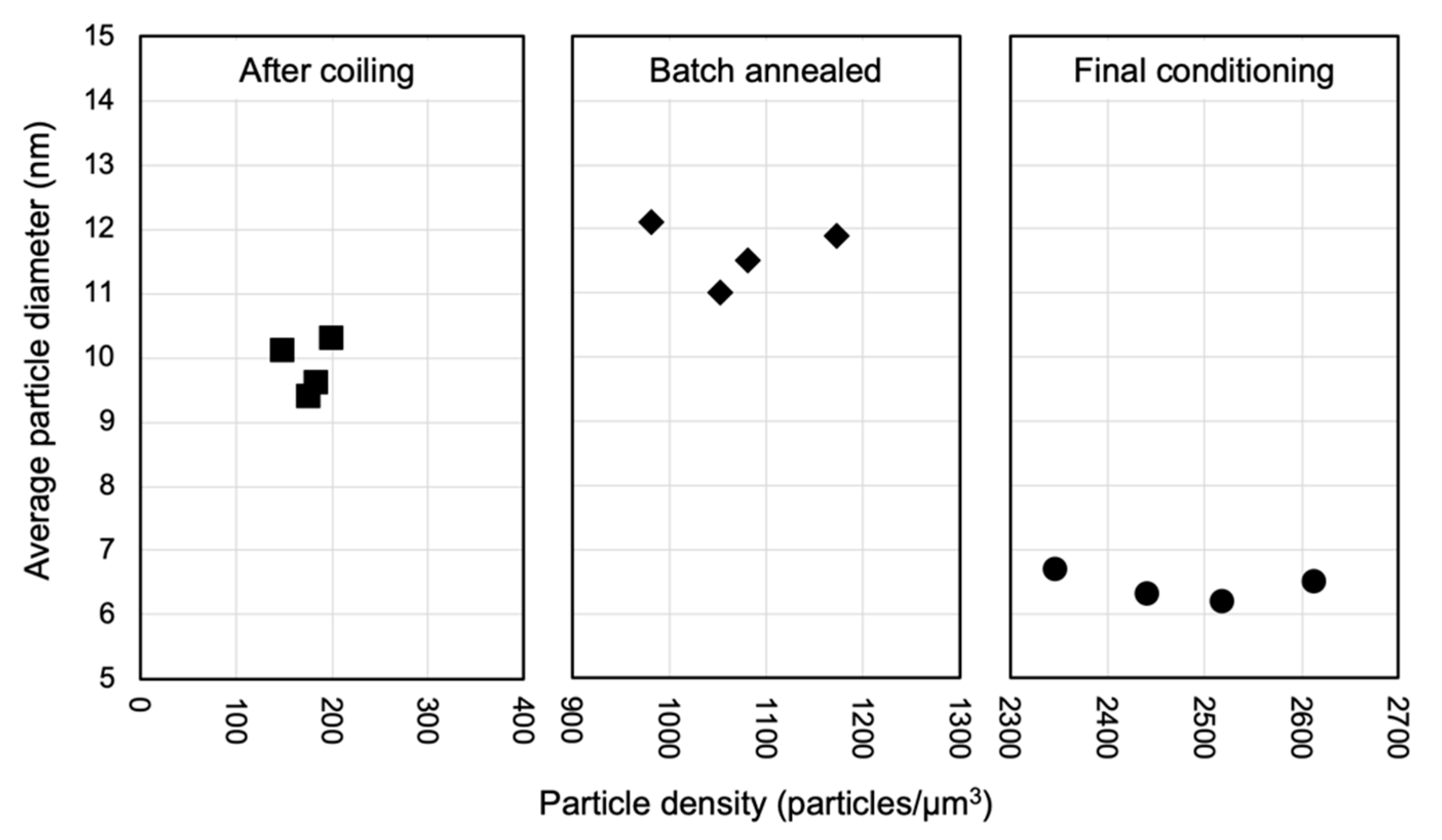
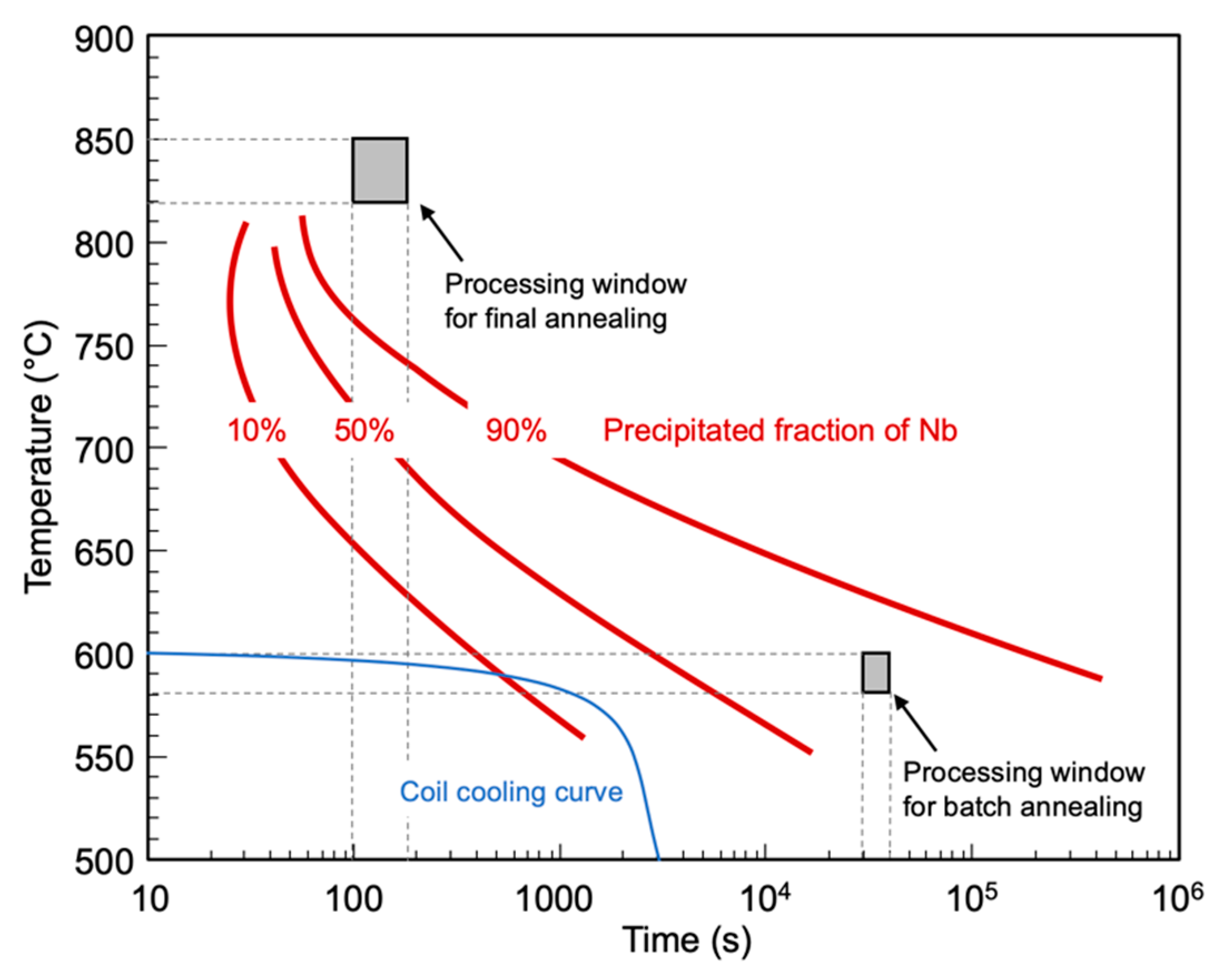

| Alloy (Mass%) | C | Mn | Si | Cr | Nb | Ti | B |
|---|---|---|---|---|---|---|---|
| DP980 HD: | ≈0.2 | 2.2–2.6 | 0.5–1.0 | <0.7 | 0.03 | <0.02 | <0.003 |
| Processing Stage | Slab Soaking | Finish Rolling | Coiling | Batch Annealing | Continuous Annealing | ||
| Temperature: | 1240 °C | >900 °C | ≈600 °C | 580 °C/10 h | 850 °C | ||
| Position in Strip | Phase Share (%) | ||
|---|---|---|---|
| Ferrite | Martensite | Austenite | |
| Head-center | 44 | 48 | 8 |
| Head-edge | 46 | 46 | 8 |
| Tail-center | 45 | 48 | 7 |
| Tail-edge | 42 | 52 | 6 |
| Processing Stage | Particle Size (nm) | Particle Count (µm−3) | Particle Volume Fraction (%) | Amount (ppm)/Share (%) of Precipitated Nb |
|---|---|---|---|---|
| Hot rolled | 9.6 | 188 | 0.004 | 35/10% |
| Batch annealed | 11.6 | 1072 | 0.023 | ~200/~70%1 |
| Final conditioning | 6.5 | 2480 | 0.034 | 303/100% |
| Steel Grade | Yield Strength Rp0.2 (MPa) | Tensile Strength Rm (MPa) | Elongation at Fracture A80 (%) | n-value | |
|---|---|---|---|---|---|
| n4-6 | n10-20 / Ag | ||||
| CR440Y780T-DH | 440–550 | 780–900 | ≥18 | ≥0.18 | ≥0.13 |
| CR700Y980T-DH | 700–850 | 980–1180 | ≥13 | - | - |
| Current production (typical values) | 740 | 1030 | 15 | ≥0.14 | ≥0.12 |
© 2020 by the authors. Licensee MDPI, Basel, Switzerland. This article is an open access article distributed under the terms and conditions of the Creative Commons Attribution (CC BY) license (http://creativecommons.org/licenses/by/4.0/).
Share and Cite
Mohrbacher, H.; Yang, J.-R.; Chen, Y.-W.; Rehrl, J.; Hebesberger, T. Metallurgical Effects of Niobium in Dual Phase Steel. Metals 2020, 10, 504. https://doi.org/10.3390/met10040504
Mohrbacher H, Yang J-R, Chen Y-W, Rehrl J, Hebesberger T. Metallurgical Effects of Niobium in Dual Phase Steel. Metals. 2020; 10(4):504. https://doi.org/10.3390/met10040504
Chicago/Turabian StyleMohrbacher, Hardy, Jer-Ren Yang, Yu-Wen Chen, Johannes Rehrl, and Thomas Hebesberger. 2020. "Metallurgical Effects of Niobium in Dual Phase Steel" Metals 10, no. 4: 504. https://doi.org/10.3390/met10040504
APA StyleMohrbacher, H., Yang, J.-R., Chen, Y.-W., Rehrl, J., & Hebesberger, T. (2020). Metallurgical Effects of Niobium in Dual Phase Steel. Metals, 10(4), 504. https://doi.org/10.3390/met10040504






